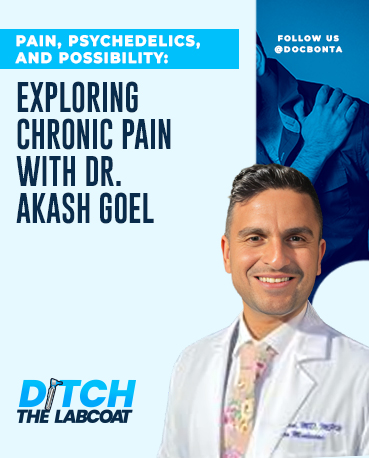Ah, pain. A universal, human, often maddening experience that ranges from the sharp burn of touching a hot stove to the soul-sapping endurance test of chronic pain. In this episode, I had the privilege of speaking with Dr. Akash Goel, a pioneer in chronic pain management and psychedelics research. Our conversation ranged from the science of pain to the potential role of MDMA (yes, ecstasy) in pain treatment. Let’s unpack some of the most intriguing points:
Acute vs. Chronic Pain: A Tale of Two (Very Different) Experiences
Dr. Goel kicked things off by drawing a line in the sand between acute and chronic pain. Acute pain? That’s your nervous system doing its job. Step on a Lego, and pain races through your body, triggering a fight-or-flight response that’s helped humans evade sabretooth tigers and worse over millennia. It’s adaptive.
But chronic pain? That’s the nervous system gone rogue. After three months or more of persistent pain, the brain can’t distinguish between hurt and harm. What started as a protective mechanism becomes a maladaptive loop—a physiological Groundhog Day where the alarm system blares constantly, even though the fires long gone. Chronic pain, Dr. Goel explained, becomes a disease in its own right, not just a symptom of something else.
Measuring Pain: A Numbers Game or an Art Form?
The challenge with chronic pain is that it’s subjective. Dr. Goel and I discussed the pain scale, where patients rate their pain from zero (no pain) to ten (worst imaginable pain). Sounds straightforward, right? Not quite. “A 4 for one person might be a 10 for another,” Goel noted. He also emphasized the importance of believing patients when they say they’re in pain—a simple yet often overlooked tenet in medicine.
Quantifying pain remains tricky. Advanced tools like functional MRI and EEG are emerging to track brain activity during pain, but they’re far from routine. Meanwhile, wearables—those step counters and sleep trackers—offer intriguing possibilities for gauging the disability pain causes. Can you pick up your child? Can you get groceries? These measures of interference, Dr. Goel argued, might be more valuable than asking patients to score their pain.
The Neuroscience of Chronic Pain: Rewiring a Jammed Circuit
One of the more fascinating parts of our discussion revolved around central sensitization—a condition where the nervous system becomes hyper-sensitive, like a microphone turned up to 11. Chronic pain rewires the brain’s pain-processing centers, such as the amygdala (the fear processor), creating a vicious cycle of fear-avoidance behavior.
Imagine your pain-processing brain region as a bodybuilder. Chronic pain is like giving it endless reps at the gym, strengthening its ability to feel pain. Breaking that cycle requires more than treating the original injury; it means addressing the maladaptive rewiring at the brain level.
Listen Now: Treatments for Patients with Central Sensitivity Syndromes with Dr Ric Arseneau
Enter Psychedelics: A New Frontier in Pain Management
Now for the headline act: MDMA. Yes, the same substance that makes rave-goers dance like nobody’s watching is being studied for its therapeutic potential in chronic pain. Why? Psychedelics like MDMA and ketamine appear to promote neuroplasticity, helping the brain form healthier connections.
Dr. Goel described his work on combining MDMA with psychotherapy, a one-two punch designed to help patients not just cope with their pain but rewire how they process it. “MDMA isn’t a magic bullet,” Goel cautioned. Instead, it’s a catalyst, making patients more receptive to therapies like cognitive-behavioral therapy (CBT) or mindfulness-based meditation.
And while MDMA may sound edgy, it’s not without precedent. Ketamine, another substance with club-drug roots, is already used for treatment-resistant depression and chronic pain. Dr. Goel’s research team is meticulously studying dosages, safety profiles, and delivery methods to ensure MDMA is both safe and effective.
Reimagining Chronic Pain Care: The Billion-Dollar Question
We also tackled the elephant in the room: access. Psychedelic-assisted therapy is resource-intensive, requiring trained therapists and controlled settings. How do we scale that in healthcare systems already stretched thin?
Goel floated a provocative vision: AI psychotherapists and VR headsets delivering guided therapy sessions. “It sounds sci-fi,” he admitted, “but it’s worth exploring.” With wearables predicting pain flares and technology democratizing care, the future might look very different.
Listen Now: Marrying Tech with Medicine: A Conversation with your IT Doc, Dr. James East
What’s Next?
As we wrapped up, I couldn’t help but admire Dr. Goel’s optimism. Chronic pain is a beast of a condition, affecting millions and defying easy fixes. But research like his represents a glimmer of hope—a new way of thinking about pain that focuses on empowering patients to lead meaningful lives, not just on masking symptoms.
And while psychedelics might not be a panacea, they’re a promising tool in a growing arsenal. So, here’s to pushing boundaries, rewiring brains, and maybe, just maybe, redefining what it means to live pain-free.
Until next time, stay curious—and maybe a little skeptical. After all, that’s where science begins.

